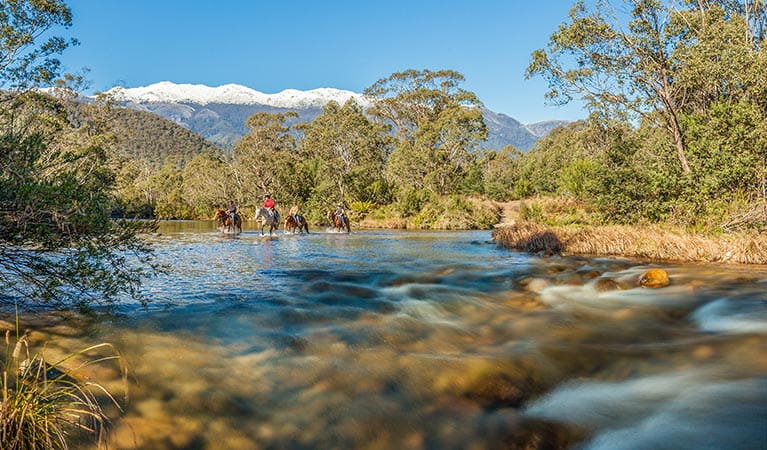Khancoban area
Kosciuszko National Park
Khancoban area is the western gateway to Kosciuszko National Park. Discover Geehi and Tom Groggin’s camp spots, fishing and riding. Marvel at the Western Fall views, or explore huts and hikes in the Jagungal Wilderness.
Read more about Khancoban area
From Khancoban, head south on Alpine Way towards Thredbo. You'll be rewarded with epic views of the Western Fall’s jagged peaks. This is the steepest part of the Snowy Mountains, and a detour to Scammells or Olsen’s lookout is essential to take in the panoramic views.
Set up camp, or picnic by the Swampy Plains River at Geehi Flats or secluded Old Geehi campground, and watch the sun set on Australia’s highest mountains. Tom Groggin campground is a favourite with campers and fishing fans. See if the rainbow or brown trout are biting in the the upper Murray River.
The National trail runs from Tom Groggin, via Geehi horse camp, north to Selwyn area. There are also plenty of walks and trails to tempt you to enjoy the scenery. Discover the area's historic huts by foot, mountain bike, or 4WD.
In summer, the winding Khancoban to Kiandra drive climbs to central Kosciuszko. Visit Cabramurra, Australia’s highest town or, if you’re well-prepared, hike the wild and remote back country of the Jagungal Wilderness.
The Khancoban Visitor Centre is a handy stop for help with inspiration, maps and entry passes before you explore.
Local alerts
For the latest updates on fires, closures and other alerts in this area, see https://www.nationalparks.nsw.gov.au/visit-a-park/parks/khancoban-area/local-alerts
Map
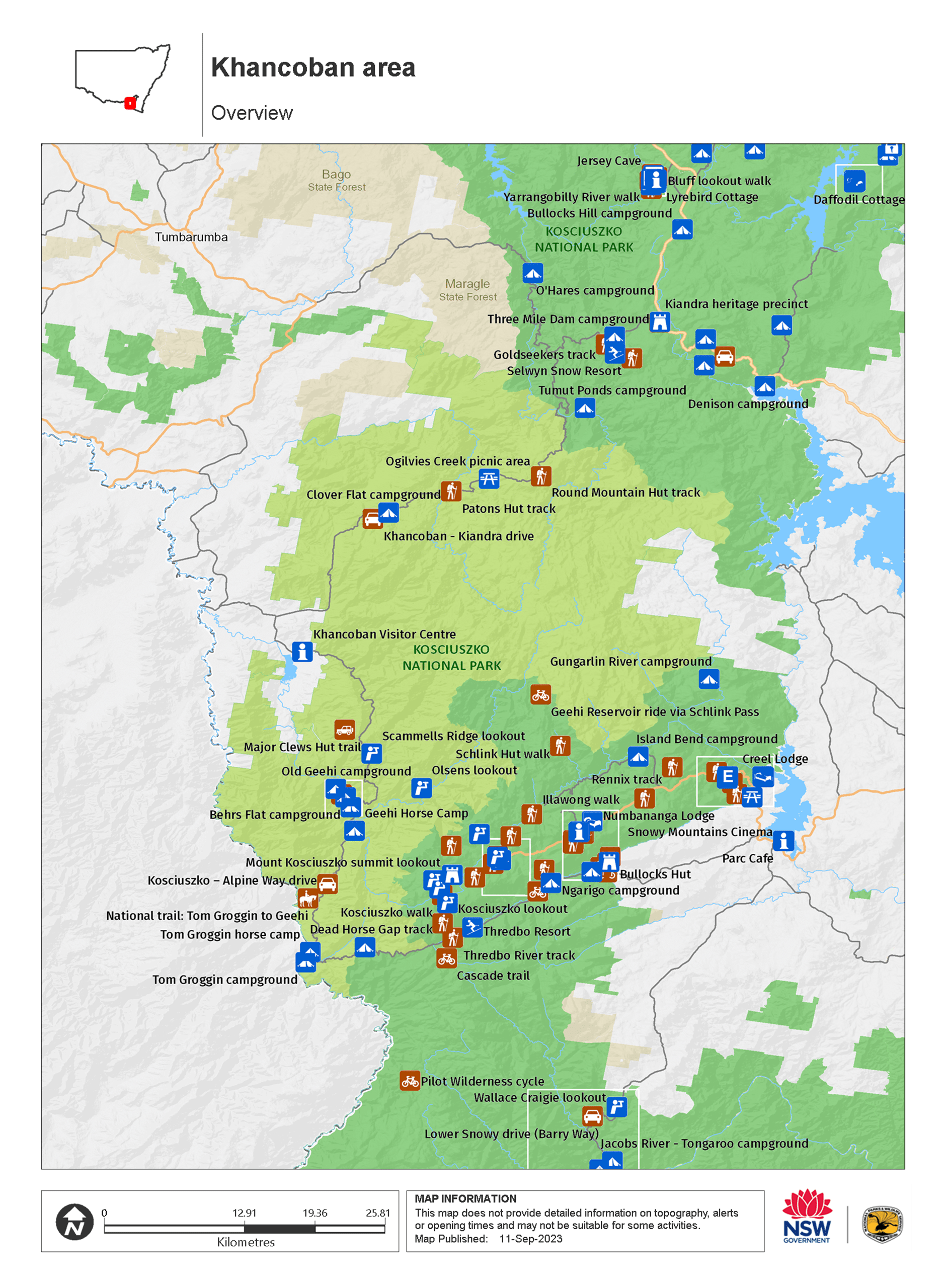
Map legend

Map
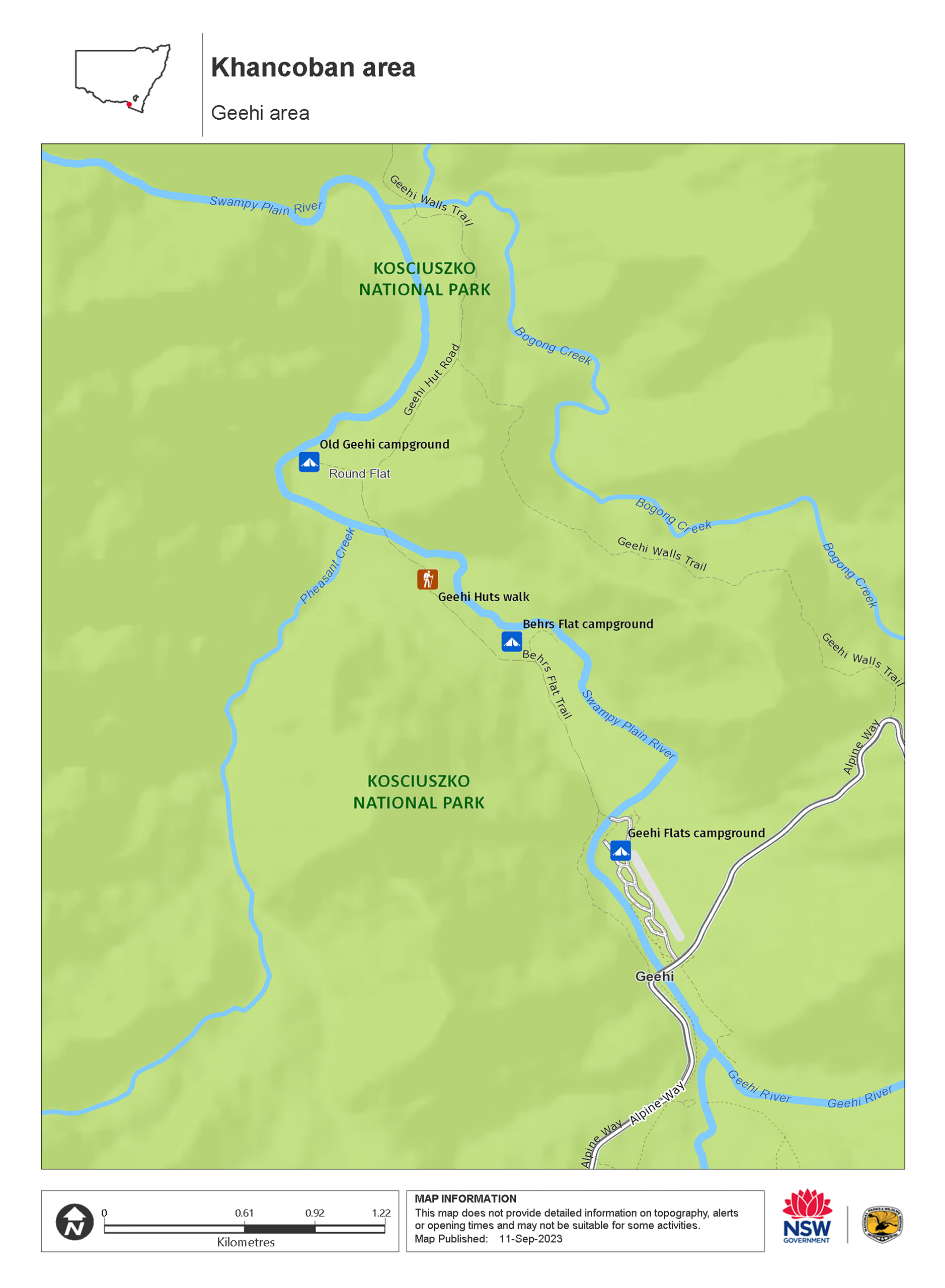
Contact
- in Kosciuszko National Park in the Snowy Mountains region
The Khancoban area is open all year, but access along the Khancoban to Cabramurra Road is closed in winter (June to October long weekends).
-
Park entry fees apply on Alpine Way
Winter (June to October long weekends): $29 per vehicle per day (24hrs from purchase); motorcycles $12; bus passengers $11.45 per adult, $3.60 per child per day. Find out more about the winter entry surcharge.
Rest of Year: $17 per vehicle per day (24hrs); motorcycles $7; bus passengers $6.60 per adult, $2.20 per child per day.
Passes: Single and Multi-Day passes available from Khancoban Visitor Centre's 24-hour vending machines, or via the Park'nPay app.
See vehicle entry fees for other areas in Kosciuszko National Park.
Buy annual pass -
-
Khancoban Visitor Centre
02 6070 8400
Contact hours: Winter (June to September): Open 9am to 4pm Monday to Friday and 10am to 2pm on weekends. Rest of year: Open 9am to 4pm daily. Closed Christmas Day. - 2 Scammel Street, Khancoban NSW 2642
-
Email: info.khancoban@environment.nsw.gov.au
-
Khancoban Visitor Centre
Visitor info
All the practical information you need to know about the Khancoban area.
Getting there and parking
Get driving directions
To get to attractions in the Khancoban area of Kosciuszko National Park:
South of Khancoban:
- Alpine Way connects Khancoban with Jindabyne via Geehi, Tom Groggin and Thredbo
Northeast of Khancoban:
- Follow the scenic Khancoban-Kiandra route along Swampy Plains Creek Road and Tooma Road to Cabramurra (road closed June to October long weekends)
- Then connect with Link Road to Kiandra and Snowy Mountains Highway
The nearest fuel and supplies are located in Khancoban and Tumbarumba.
Parking Show more
- Geehi Flats campground See on map
- Geehi huts walking track See on map
- Khancoban Visitor Centre See on map
- Leatherbarrel Creek picnic area See on map
- National trail: Tom Groggin to Geehi See on map
- Olsens lookout See on map
- Scammells Ridge lookout See on map
Road quality
Alpine Way is steep, narrow and winding between Khancoban and Thredbo, and subject to rockfalls after rain. This section is not recommended for vehicles towing large caravans.
Winter season road closures
The scenic Khancoban-Kiandra drive, along Swampy Plains Creek Road and Tooma Road, is closed between Khancoban and Cabramurra from the June and October long weekends.
Snow chains
It's compulsory for all 2WD vehicles to carry snow chains in winter, between June and October long weekends, on:
- Alpine Way between Tom Groggin and Thredbo
- Kosciuszko Road (to Perisher)
- Guthega Road
The Roads and Maritime Service (RMS) recommends snow chains are carried by all vehicles driving in the park in winter, including 4WD and AWD, in the event of extreme weather. Visit the Live Traffic website for current conditions.
Best times to visit
The Khancoban area is packed with activities and experiences. Here are some of the highlights.
Autumn
Enjoy the fresh air on a walk to Geehi’s many historic huts, or horse ride with the majestic Western Fall as a backdrop. Hike amongst the plains and snow gums of the Jagungal Wilderness back country, which rises over 1700m. If you’re lucky, there might be early snow on the mountains. Now’s your last chance to see what’s biting in the rivers and streams before fishing season closes for winter.
Spring
Snowmelt fills the rivers and the first wildflowers carpet the lower valleys, attracting plenty of animals - great for birdwatching. It's time to unpack the tent to camp under the stars and enjoy the show as the roos, red-necked wallabies, and wombats come out to graze and the sunset turns the Western Fall pink and orange.
Summer
Cool off on hot summer days with a swim in the Swampy Plains River at Geehi or Tom Groggin’s Murray River. You may even see young wombats with their mums between June and September. Lower water levels make this the safest time to explore by 4WD. Wildflowers peak in early summer in the high country along the scenic Khancoban to Kiandra drive. The short walks to historic Round Mountain Hut and Patons Hut are a perfect introduction to this remote area, if you’re not prepared to tackle back country hiking.
Winter
Stop by Scammells lookout as you drive Alpine Way towards the Thredbo ski fields. Take time to absorb the marvellous views of the Main Range’s Western Fall blanketed in snow. The 10km gravel road to Olsen’s lookout gets you even closer. It’s the ultimate wide-angle view of tall mountain ash forest giving way to jagged rock slopes that climb to the rooftop of Australia. Selwyn Snow Resort can be reached via the Elliott Way.
Facilities
Toilets Show more
- Geehi Flats campground
- Geehi huts walking track
- Khancoban Visitor Centre
- Leatherbarrel Creek picnic area
- National trail: Tom Groggin to Geehi
- Old Geehi campground
- Scammells Ridge lookout
- Tom Groggin campground
Picnic tables Show more
- Geehi Flats campground
- Geehi huts walking track
- Khancoban Visitor Centre
- Leatherbarrel Creek picnic area
- National trail: Tom Groggin to Geehi
- Old Geehi campground
- Olsens lookout
- Scammells Ridge lookout
- Tom Groggin campground
Barbecue facilities Show more
Drinking water
Maps and downloads
Fees and passes
Park entry fees apply on Alpine Way
Winter (June to October long weekends): $29 per vehicle per day (24hrs from purchase); motorcycles $12; bus passengers $11.45 per adult, $3.60 per child per day. Find out more about the winter entry surcharge.
Rest of Year: $17 per vehicle per day (24hrs); motorcycles $7; bus passengers $6.60 per adult, $2.20 per child per day.
Passes: Single and Multi-Day passes available from Khancoban Visitor Centre's 24-hour vending machines, or via the Park'nPay app.
See vehicle entry fees for other areas in Kosciuszko National Park.
- All Parks Pass - For all parks in NSW (including Kosciuszko NP) $190 (1 year) / $335 (2 years)
Annual passes and entry fees (https://www.nationalparks.nsw.gov.au/passes-and-fees)
Permitted
Camping
Vehicle-based camping is only permitted at designated campgrounds. If you’re planning to go back country camping in the Jagungal Wilderness please read our back country safety tips. Huts are for emergency use only.
Cycling
Cycling is permitted on public roads, along fire trails in the Geehi and Tom Groggin areas. Please take care if road cycling along the narrow and winding Alpine Way. Within the Jagungal Wilderness Area, you can cycle only on Round Mountain trail, Dargans trail, Hellhole Creek trail, Valentine trail, and Grey Mare trail. Riders please give way to walkers.</p>
Fishing
You can fish in rivers and streams between the October and June long weekends. A current NSW recreational fishing licence is required to fish in all waters. Fishing in dams and lakes is permitted year-round, but some waterways may close temporarily or have restrictions. Refer to the NSW Recreational Freshwater Fishing Guide for information.
Horses
An upgraded section of the well-signposted National trail runs from Tom Groggin, via Geehi, into the Selwyn area of the park.
Prohibited
Firearms, chainsaws and fossicking are not permitted in Kosciuszko National Park.
Drones
Flying a drone for recreational purposes is prohibited in this area. Drones may affect public enjoyment, safety and privacy, interfere with park operations, or pose a threat to wildlife. See the Drones in Parks policy.
This area may be a declared Drone Exclusion Zone, or may be subject to Civil Aviation Safety Authority (CASA) rules for flying near airports, aerodromes and helicopter landing sites. See CASA's Drone Flyer Rules.
Commercial filming and photography
Commercial filming or photography is prohibited without prior consent. You must apply for permission and contact the local office.
Pets
Pets and domestic animals (other than certified assistance animals) are not permitted. Find out which regional parks allow dog walking and see the pets in parks policy for more information.
Smoking
NSW national parks are no smoking areas. The alpine resorts of Thredbo, Perisher, Charlotte Pass, Selwyn, Ski Rider and Kosciuszko Tourist Park are exempt, though some commercial and outdoor places within these resorts may have no smoking areas.
Visitor centre
-
Khancoban Visitor Centre
2 Scammel Street, Khancoban NSW 2642 - Winter (June to September): Open 9am to 4pm Monday to Friday and 10am to 2pm on weekends. Rest of year: Open 9am to 4pm daily. Closed Christmas Day.
- 02 6070 8400
Nearby towns
Khancoban (3 km)
Plan ahead for your Snowy Mountains getaway and check out what's on in Khancoban. Extreme athletes love the Upper Murray Challenge that consists of a 38-km bike ride, a 26-km paddle and a 25-km run. The annual Khancoban TroutFest takes place every November at several area fishing holes.
Tumbarumba (42 km)
Learn more
Khancoban area is a special place. Here are just some of the reasons why:
Unique landscapes
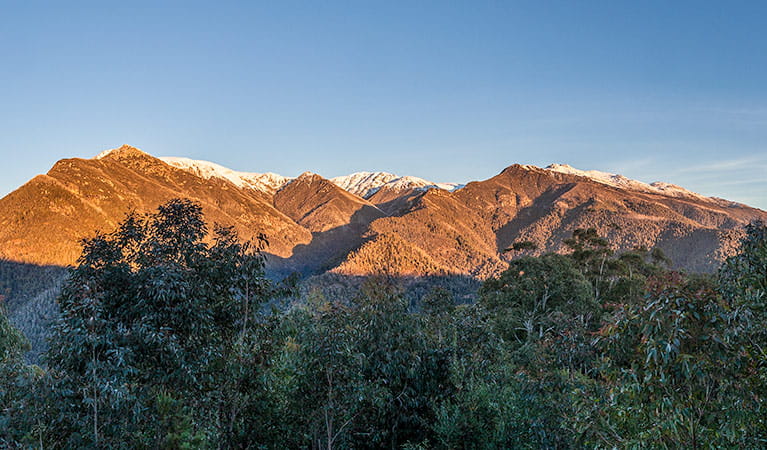
The Western Fall of Kosciuszko National Park’s Main Range is the highest and steepest part of the Snowy Mountains. Mount Townsend and Abbot Peak block the view to Mount Kosciuszko, but their towering, rocky peaks are a breathtaking backdrop to the Geehi Plains, 1600m below. The mountain range captures the westerly air stream allowing tall mountain ash forest to grow in the moist soil below the treeline.
The man-made landscapes of the Snowy Hydro Scheme, one of the civil engineering wonders of the modern world, are also on show. Murray 1 and 2 Power Stations are close to Khancoban, while the scenic drive to Kiandra travels across the very top of the Tumut Pond Reservoir wall.
- Scammells Ridge lookout Scammells Ridge lookout, 1000m above sea level, offers marvellous views of the rugged Western Fall of the Main Range, and makes a scenic picnic spot just off Alpine Way.
Historic alpine huts
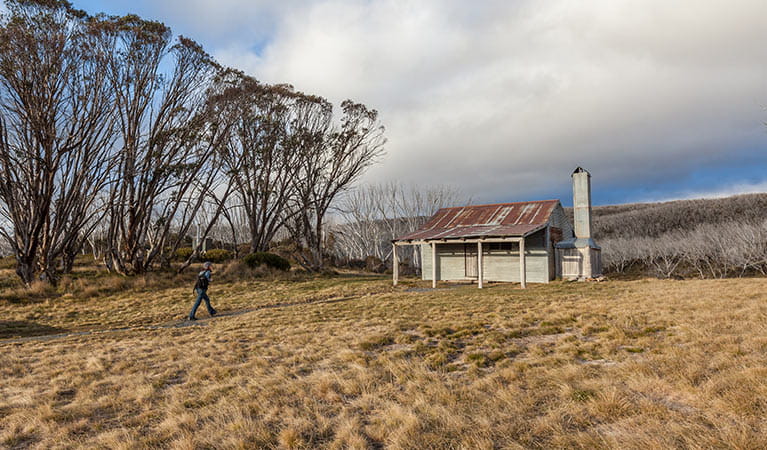
The Khancoban area is home to many of Kosciuszko National Park’s picturesque historic huts. Built as shelter or fishing retreats for graziers and prospectors, or like Major Clews Hut, by Snowy Hydro Scheme workers, the huts provide a window into the past. The 8km return Geehi Huts walk is a great way to see Geehi, Keeble’s and Old Geehi Huts, all constructed from river rocks. Be prepared for several river crossings. Bradleys and O’Brien’s Hut is hard to miss along the Khancoban to Kiandra drive. You can also stretch your legs on a short walk to the rustic Patons Hut or Round Mountain Hut, made out of corrugated iron and surrounded by wilderness.
- Geehi huts walking track Explore Geehi huts walking track by foot, bike, horse or 4WD. This short track, near Khancoban, boasts historic huts, river crossings and magnificent views of the Snowy Mountains in Kosciuszko National Park.
- National trail: Tom Groggin to Geehi Ride, cycle, or hike 21km of National trail in Kosciuszko National Park. Saddle up your horses for a day of high-country adventure on this epic ride from Tom Groggin to Geehi horse camp.
- Round Mountain Hut walking track Round Mountain Hut walking track winds through the Jagungal Wilderness Area in central Kosciuszko National Park. A great Snowy Mountains walk or ride, it offers view and spring wildflowers on its way to the rustic hut.
Discover western and central Kosciuszko
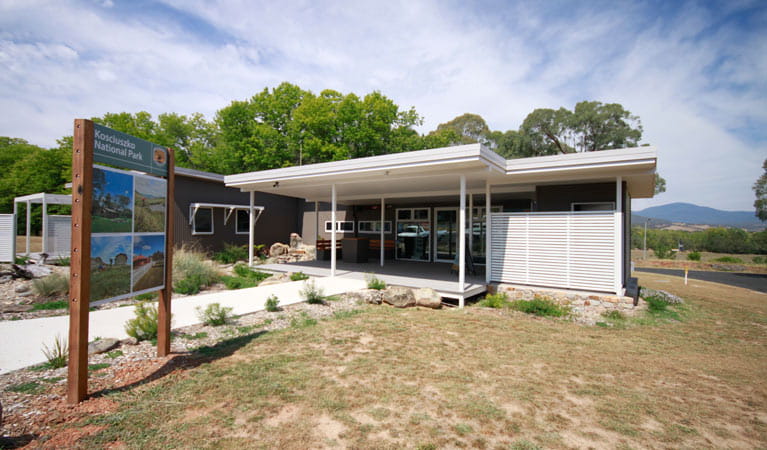
Khancoban Visitor Centre is a convenient stop to buy passes, get maps, information and inspiration before you enter the park. Alpine Way is the main, year-round route through this area. It offers lookouts, campgrounds, picnic areas, walking tracks and bike trails along its 108km length between Khancoban and Jindabyne. The area's upgraded section of the National trail is popular with horse riders, who can also take advantage of horse camps near Geehi and Tom Groggin.
- Khancoban to Kiandra drive Picturesque Khancoban to Kiandra drive links Alpine Way with Snowy Mountains Highway, in Kosciuszko National Park, and takes in scenic dams, historic huts, mountain forest, and the highest town in Australia.
- Khancoban Visitor Centre Khancoban Visitor Centre, on Alpine Way at western entry point to Kosciuszko National Park, is a great place to pick up maps, information and buy a parks pass for your Snowy Mountains adventure.
- Kosciuszko – Alpine Way drive A driving or motorbike tour along Alpine Way scenic drive is a great way to discover the spectacular mountain views, serene campgrounds, magnificent walks, rides, and heritage of southern Kosciuszko National Park.
- National trail: Tom Groggin to Geehi Ride, cycle, or hike 21km of National trail in Kosciuszko National Park. Saddle up your horses for a day of high-country adventure on this epic ride from Tom Groggin to Geehi horse camp.
Remote wilderness and rare species
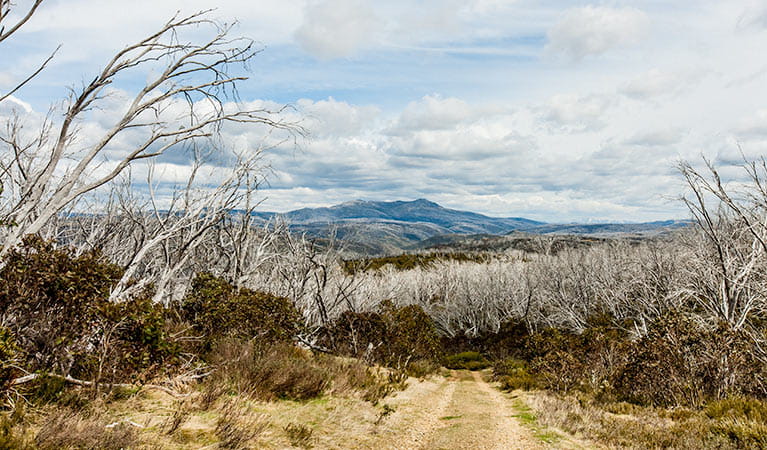
In recognition of Kosciuszko's unique value as a conservation area, it’s been named a UNESCO Biosphere Reserve. More than half of the park, over 350,000ha (almost 865,000 acres), has been declared wilderness, including the Jagungal, Western Fall and Indi wilderness areas, located in the Khancoban area. The park's alpine and sub-alpine areas are home to rare plant species found nowhere else in the world, such as the Southern corroboree frog.
- Round Mountain Hut walking track Round Mountain Hut walking track winds through the Jagungal Wilderness Area in central Kosciuszko National Park. A great Snowy Mountains walk or ride, it offers view and spring wildflowers on its way to the rustic hut.
Plants and animals protected in this park
Animals
-
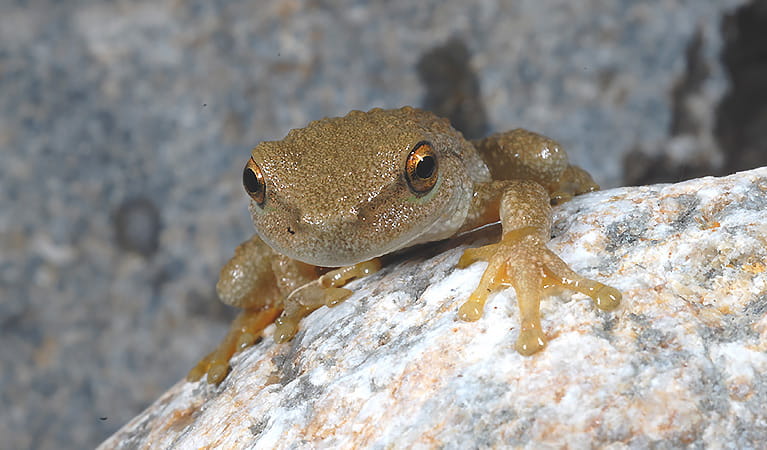
Spotted tree frog (Litoria spenceri)
The spotted tree frog is a rare Australian frog that lives in only a small number of high mountain streams, including a single location in Kosciuszko National Park. It’s listed as critically endangered in NSW.
-

Bare-nosed wombat (Vombatus ursinus)
A large, squat marsupial, the Australian bare-nosed wombat is a burrowing mammal found in coastal forests and mountain ranges across NSW and Victoria. The only other remaining species of wombat in NSW, the endangered southern hairy-nosed wombat, was considered extinct until relatively recently.
-
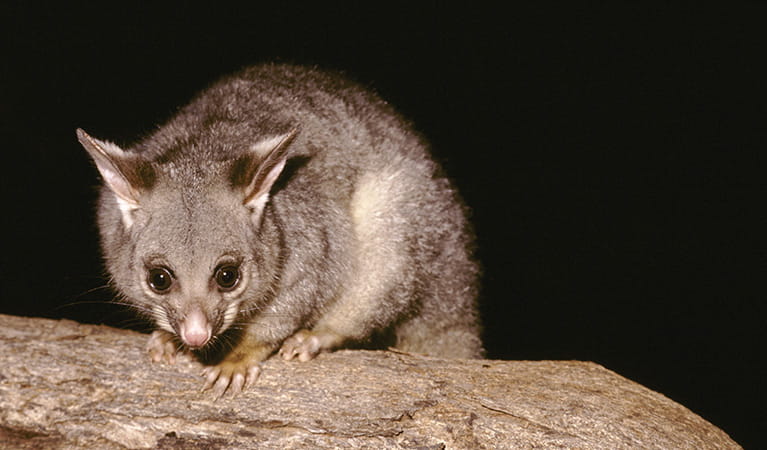
Common brushtail possum (Trichosurus vulpecula)
One of the most widespread of Australian tree-dwelling marsupials, the common brushtail possum is found across most of NSW in woodlands, rainforests and urban areas. With strong claws, a prehensile tail and opposable digits, these native Australian animals are well-adapted for life amongst the trees.
-

Common ringtail possum (Pseudocheirus peregrinus)
Commonly found in forests, woodlands and leafy gardens across eastern NSW, the Australian ringtail possum is a tree-dwelling marsupial. With a powerful tail perfectly adapted to grasp objects, it forages in trees for eucalypt leaves, flowers and fruit.
-
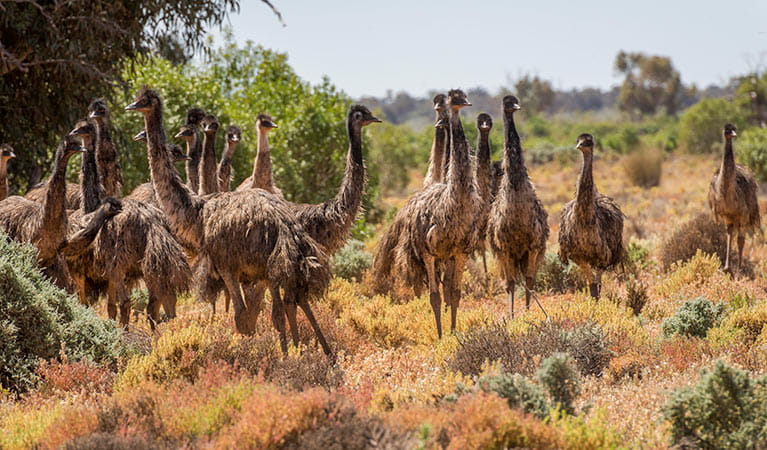
Emu (Dromaius novaehollandiae)
The largest of Australian birds, the emu stands up to 2m high and is the second largest bird in the world, after the ostrich. Emus live in pairs or family groups. The male emu incubates and rears the young, which will stay with the adult emus for up to 2 years.
-
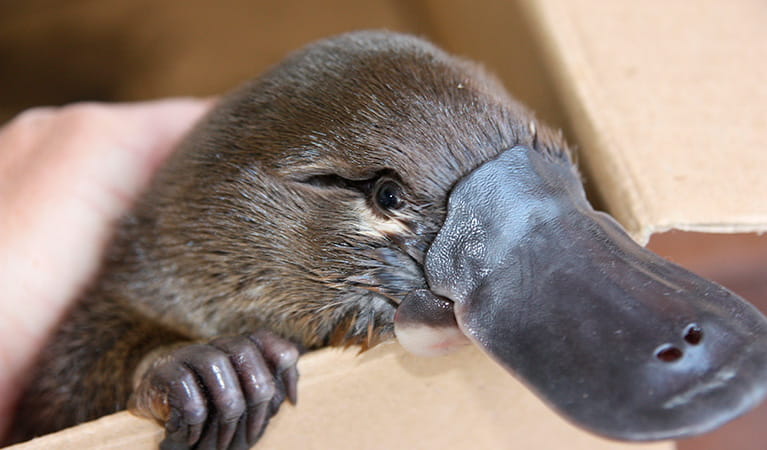
Platypus (Ornithorhynchus anatinus)
One of the most fascinating and unusual Australian animals, the duck-billed platypus, along with the echidna, are the only known monotremes, or egg-laying mammals, in existence. The platypus is generally found in permanent river systems and lakes in southern and eastern NSW and east and west of the Great Dividing Range.
-
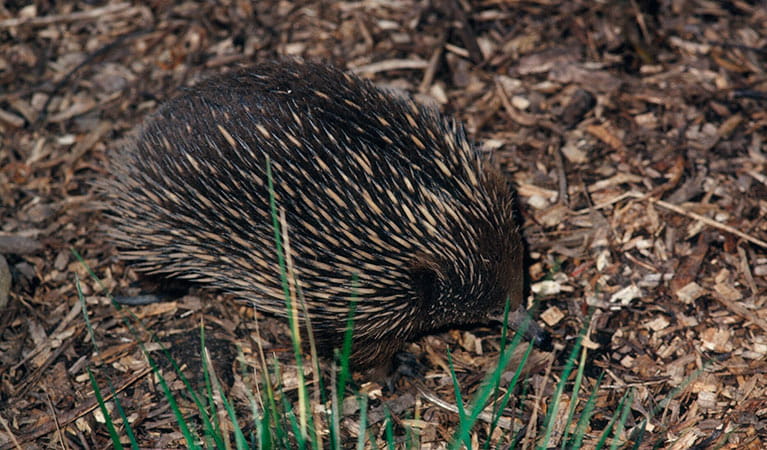
Short-beaked echidna (Tachyglossus aculeatus)
One of only 2 egg-laying mammals in the world, the short-beaked echidna is one of the most widespread of Australian native animals. Covered in spines, or quills, they’re equipped with a keen sense of smell and a tube-like snout which they use to break apart termite mounds in search of ants.
-

Superb lyrebird (Menura novaehollandiae)
With a complex mimicking call and an elaborate courtship dance to match, the superb lyrebird is one of the most spectacular Australian animals. A bird watching must-see, the superb lyrebird can be found in rainforests and wet woodlands across eastern NSW and Victoria.
-

Swamp wallaby (Wallabia bicolor)
The swamp wallaby, also known as the black wallaby or black pademelon, lives in the dense understorey of rainforests, woodlands and dry sclerophyll forest along eastern Australia. This unique Australian macropod has a dark black-grey coat with a distinctive light-coloured cheek stripe.
Plants
-
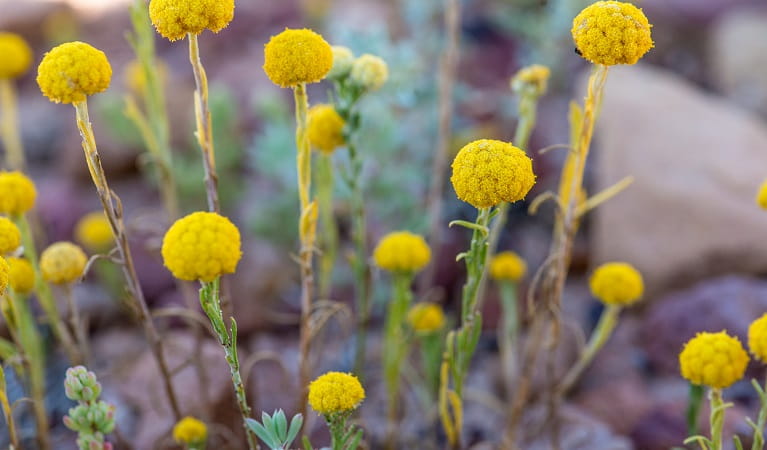
Billy buttons (Craspedia spp. )
Billy buttons are attractive Australian native plants that are widespread throughout eastern NSW in dry forest, grassland and alpine regions such as Kosciuszko National Park. The golden-yellow globe-shaped flowers are also known as woollyheads. Related to the daisy, billy buttons are an erect herb growing to a height of 50cm.
Environments in this area
What we're doing
Khancoban area has management strategies in place to protect and conserve the values of this park. Visit the OEH website for detailed park and fire management documents. Here is just some of the work we’re doing to conserve these values:
Understanding landscapes and geology
Geo conservation efforts play an important role in protecting the delicate ecosystems of Kosciuszko National Park. Rehabilitation and maintenance works to limit the impact of erosion and degradation, and monitoring the effects of climate change and visitation, are ongoing.
Preserving biodiversity
Kosciuszko National Park plays an important role in conserving NSW’s biodiversity by protecting its vulnerable, threatened and endangered species. Conservation activities, such as the Saving Our Species and Southern corroboree frog conservation programs, are carried out in this area of the park. These activities include monitoring species’ habitats, distribution and population.
Historic heritage in our parks and reserves
The historic heritage of Kosciuszko National Park is preserved through a variety of NSW National Parks and Wildlife Service (NPWS) programs that embrace its past. Heritage revitalisation and adaptive reuse projects are ongoing in this park. NPWS also works with the Kosciuszko Huts Association to preserve and maintain historic huts in the Khancoban area.
Managing weeds, pest animals and other threats
Pests and weeds have a significant impact on the ecosystems and habitats within Kosciuszko National Park. Reduction of species such as deer and pigs, and invasive orange and mouse-ear hawkweed, are an important part of NPWS’ work to protect the integrity of the Khancoban area.
Developing visitor facilities and experiences
NPWS is committed to developing facilities for the enjoyment and safety of visitors to Kosciuszko National Park. Visitor feedback and environmental sustainability are key considerations in park maintenance, and upgrades are ongoing. Horse riding trails and camps are continually maintained and upgraded, and NPWS regularly reviews the park’s recreational opportunities, identifying areas for improvement or addition. Hazard assessments are also ongoing.
Kosciuszko National Park has achieved Australia’s first Ecotourism Destination Certification, through Ecotourism Australia, recognising best practice sustainable tourism and visitation in protected areas.
Managing fire
NSW is one of the most bushfire prone areas in the world due to our climate, weather systems, vegetation and the rugged terrain. NPWS is committed to minimising the likelihood and impact of bushfires via a strategic program of fire research, fire planning, hazard reduction, highly trained rapid response firefighting crews and community alerts.
General enquiries
- National Parks Contact Centre
- 7am to 7pm daily
- 1300 072 757 (13000 PARKS) for the cost of a local call within Australia excluding mobiles
- parks.info@environment.nsw.gov.au
Contact
- in Kosciuszko National Park in the Snowy Mountains region
The Khancoban area is open all year, but access along the Khancoban to Cabramurra Road is closed in winter (June to October long weekends).
-
Park entry fees apply on Alpine Way
Winter (June to October long weekends): $29 per vehicle per day (24hrs from purchase); motorcycles $12; bus passengers $11.45 per adult, $3.60 per child per day. Find out more about the winter entry surcharge.
Rest of Year: $17 per vehicle per day (24hrs); motorcycles $7; bus passengers $6.60 per adult, $2.20 per child per day.
Passes: Single and Multi-Day passes available from Khancoban Visitor Centre's 24-hour vending machines, or via the Park'nPay app.
See vehicle entry fees for other areas in Kosciuszko National Park.
Buy annual pass -
-
Khancoban Visitor Centre
02 6070 8400
Contact hours: Winter (June to September): Open 9am to 4pm Monday to Friday and 10am to 2pm on weekends. Rest of year: Open 9am to 4pm daily. Closed Christmas Day. - 2 Scammel Street, Khancoban NSW 2642
-
Email: info.khancoban@environment.nsw.gov.au
-
Khancoban Visitor Centre
In this area:
Things to do (35)
- 4WD touring (2)
- Adventure sports (3)
- Birdwatching and wildlife encounters (2)
- Cycling (7)
- Fishing (6)
- Historic heritage (5)
- Horse riding (2)
- Other experiences (2)
- Picnics and barbecues (5)
- Road trips and car/bus tours (3)
- Sightseeing (2)
- Snow sports (8)
- Swimming (1)
- Visitor centres (1)
- Walking (11)
- Wildflowers (seasonal) (2)

